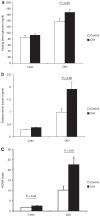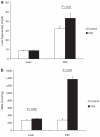Intermittent hypoxia exacerbates metabolic effects of diet-induced obesity
- PMID: 21799478
- PMCID: PMC4461029
- DOI: 10.1038/oby.2011.240
Intermittent hypoxia exacerbates metabolic effects of diet-induced obesity
Abstract
Obesity causes insulin resistance (IR) and nonalcoholic fatty liver disease (NAFLD), but the relative contribution of sleep apnea is debatable. The main aim of this study is to evaluate the effects of chronic intermittent hypoxia (CIH), a hallmark of sleep apnea, on IR and NAFLD in lean mice and mice with diet-induced obesity (DIO). Mice (C57BL/6J), 6-8 weeks of age were fed a high fat (n = 18) or regular (n = 16) diet for 12 weeks and then exposed to CIH or control conditions (room air) for 4 weeks. At the end of the exposure, fasting (5 h) blood glucose, insulin, homeostasis model assessment (HOMA) index, liver enzymes, and intraperitoneal glucose tolerance test (1 g/kg) were measured. In DIO mice, body weight remained stable during CIH and did not differ from control conditions. Lean mice under CIH were significantly lighter than control mice by day 28 (P = 0.002). Compared to lean mice, DIO mice had higher fasting levels of blood glucose, plasma insulin, the HOMA index, and had glucose intolerance and hepatic steatosis at baseline. In lean mice, CIH slightly increased HOMA index (from 1.79 ± 0.13 in control to 2.41 ± 0.26 in CIH; P = 0.05), whereas glucose tolerance was not affected. In contrast, in DIO mice, CIH doubled HOMA index (from 10.1 ± 2.1 in control to 22.5 ± 3.6 in CIH; P < 0.01), and induced severe glucose intolerance. In DIO mice, CIH induced NAFLD, inflammation, and oxidative stress, which was not observed in lean mice. In conclusion, CIH exacerbates IR and induces steatohepatitis in DIO mice, suggesting that CIH may account for metabolic dysfunction in obesity.
Figures






Similar articles
-
A rapid juvenile murine model of nonalcoholic steatohepatitis (NASH): Chronic intermittent hypoxia exacerbates Western diet-induced NASH.Life Sci. 2021 Jul 1;276:119403. doi: 10.1016/j.lfs.2021.119403. Epub 2021 Mar 27. Life Sci. 2021. PMID: 33785339
-
Down-regulation of vascular PPAR-γ contributes to endothelial dysfunction in high-fat diet-induced obese mice exposed to chronic intermittent hypoxia.Biochem Biophys Res Commun. 2017 Oct 14;492(2):243-248. doi: 10.1016/j.bbrc.2017.08.058. Epub 2017 Aug 16. Biochem Biophys Res Commun. 2017. PMID: 28822761
-
Chronic intermittent hypoxia predisposes to liver injury.Hepatology. 2007 Apr;45(4):1007-13. doi: 10.1002/hep.21593. Hepatology. 2007. PMID: 17393512
-
Obesity and nonalcoholic fatty liver disease: biochemical, metabolic, and clinical implications.Hepatology. 2010 Feb;51(2):679-89. doi: 10.1002/hep.23280. Hepatology. 2010. PMID: 20041406 Free PMC article. Review.
-
Metabolic consequences of sleep-disordered breathing.ILAR J. 2009;50(3):289-306. doi: 10.1093/ilar.50.3.289. ILAR J. 2009. PMID: 19506316 Free PMC article. Review.
Cited by
-
Investigating the causal links between obstructive sleep apnea and gastrointestinal diseases mediated by metabolic syndrome through mendelian randomization.Sci Rep. 2024 Nov 1;14(1):26247. doi: 10.1038/s41598-024-77471-x. Sci Rep. 2024. PMID: 39482370 Free PMC article.
-
Obstructive sleep apnea and non-alcoholic Fatty liver disease: is the liver another target?Front Neurol. 2012 Oct 17;3:149. doi: 10.3389/fneur.2012.00149. eCollection 2012. Front Neurol. 2012. PMID: 23087670 Free PMC article.
-
Obstructive sleep apnea: a cardiometabolic risk in obesity and the metabolic syndrome.J Am Coll Cardiol. 2013 Aug 13;62(7):569-76. doi: 10.1016/j.jacc.2013.05.045. Epub 2013 Jun 12. J Am Coll Cardiol. 2013. PMID: 23770180 Free PMC article. Review.
-
The clinical influence of nasal surgery on PAP compliance and optimal application among OSA subjects uncomfortable with PAP device wear.Sci Rep. 2023 Mar 16;13(1):4383. doi: 10.1038/s41598-023-31588-7. Sci Rep. 2023. PMID: 36928588 Free PMC article.
-
Combined intermittent and sustained hypoxia is a novel and deleterious cardio-metabolic phenotype.Sleep. 2022 Jun 13;45(6):zsab290. doi: 10.1093/sleep/zsab290. Sleep. 2022. PMID: 34893914 Free PMC article.
References
-
- Flegal KM, Carroll MD, Ogden CL, Curtin LR. Prevalence and trends in obesity among US adults, 1999-2008. JAMA. 2010;303:235–241. - PubMed
-
- Gade W, Schmit J, Collins M, Gade J. Beyond obesity: the diagnosis and pathophysiology of metabolic syndrome. Clin Lab Sci. 2010;23:51–61. quiz 62. - PubMed
-
- Young T, Peppard PE, Gottlieb DJ. Epidemiology of obstructive sleep apnea: a population health perspective. Am J Respir Crit Care Med. 2002;165:1217–1239. - PubMed
-
- Tufik S, Santos-Silva R, Taddei JA, Bittencourt LR. Obstructive sleep apnea syndrome in the Sao Paulo Epidemiologic Sleep Study. Sleep Med. 2010;11:441–446. - PubMed
-
- Lecube A, Sampol G, Lloberes P, et al. Asymptomatic sleep-disordered breathing in premenopausal women awaiting bariatric surgery. Obes Surg. 2010;20:454–461. - PubMed
Publication types
MeSH terms
Substances
Grants and funding
LinkOut - more resources
Full Text Sources
Medical

